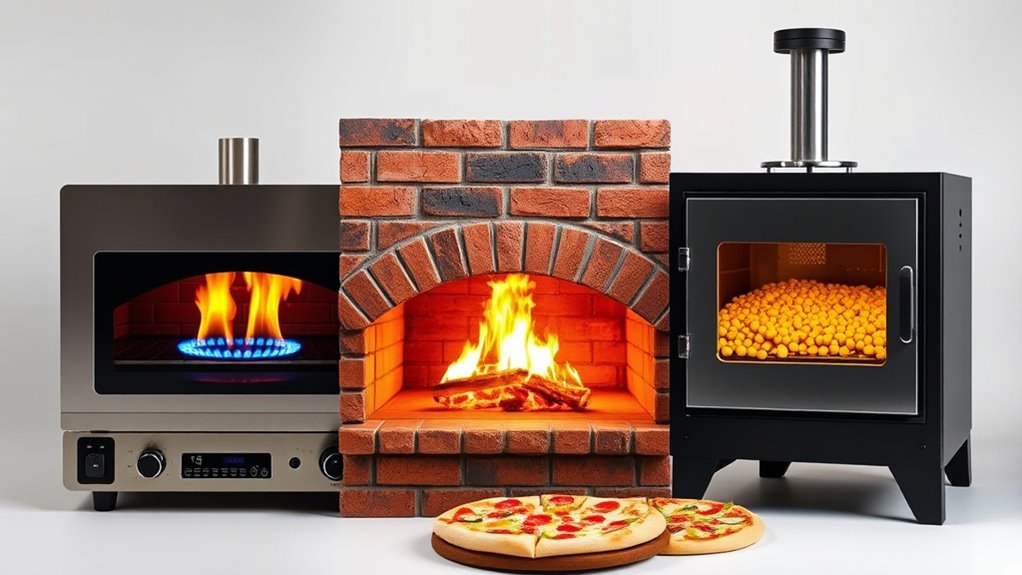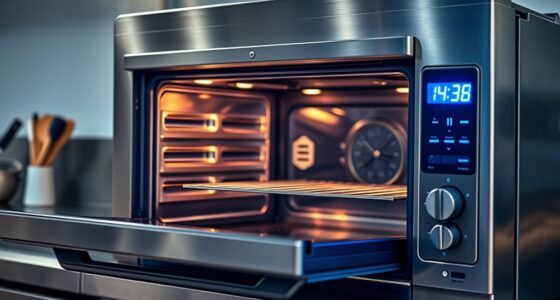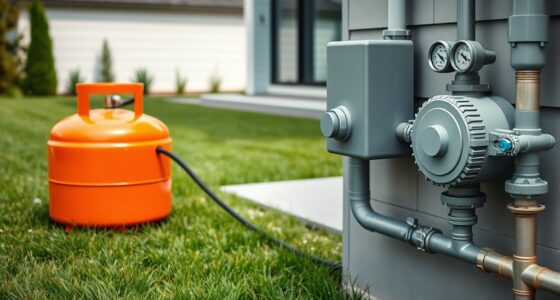Choosing between gas, wood, or pellet ovens depends on your flavor goals, convenience preferences, and budget. Gas ovens heat quickly, are easy to operate, and keep costs lower, perfect for consistent results. Wood-fired ovens add smoky depth and rustic charm but require more skill and space. Pellet ovens offer a good balance, with reliable heat and convenience. To make the best choice tailored to your pizza passion, explore further details and insights.
Key Takeaways
- Gas ovens heat quickly, offer precise temperature control, and are more affordable and easier to maintain than wood or pellet options.
- Wood-fired ovens provide authentic smoky flavors and rustic aesthetics but require longer heat-up times and more skill to operate.
- Pellet ovens balance convenience and flavor, with consistent heat, digital controls, and easier operation compared to traditional wood models.
- Gas ovens are ideal for efficiency and simplicity, while wood and pellet ovens excel in flavor complexity and artisanal pizza craftsmanship.
- Consider space, safety, and budget; gas ovens are compact and cost-effective, whereas wood and pellet ovens need more room, ventilation, and investment.
How Gas Ovens Heat and Cook Pizza
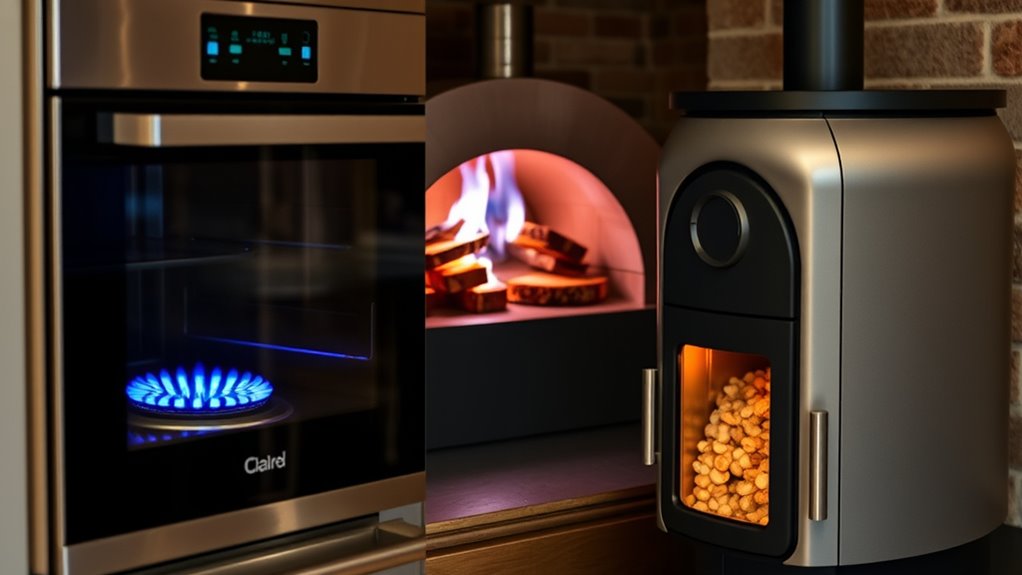
Have you ever wondered how gas ovens heat and cook pizza so quickly and evenly? It all comes down to their efficient design, especially good oven insulation that traps heat inside. This insulation keeps the oven hot, reducing heat loss and ensuring consistent cooking temperatures. Gas ovens use a controlled flame to generate heat directly, which rises evenly across the cooking chamber. Because of this, fuel consumption stays relatively low compared to other methods, making them cost-effective over time. The insulation also helps maintain stable temperatures, so your pizza cooks evenly without hot spots. This combination of insulation and precise heat control allows for rapid cooking times, giving you a crispy crust and perfectly melted toppings every time. Moreover, attention to the oven’s environment and consistent operation enhances the quality of the cooking process.
The Flavor Profile of Wood-Fired Pizzas
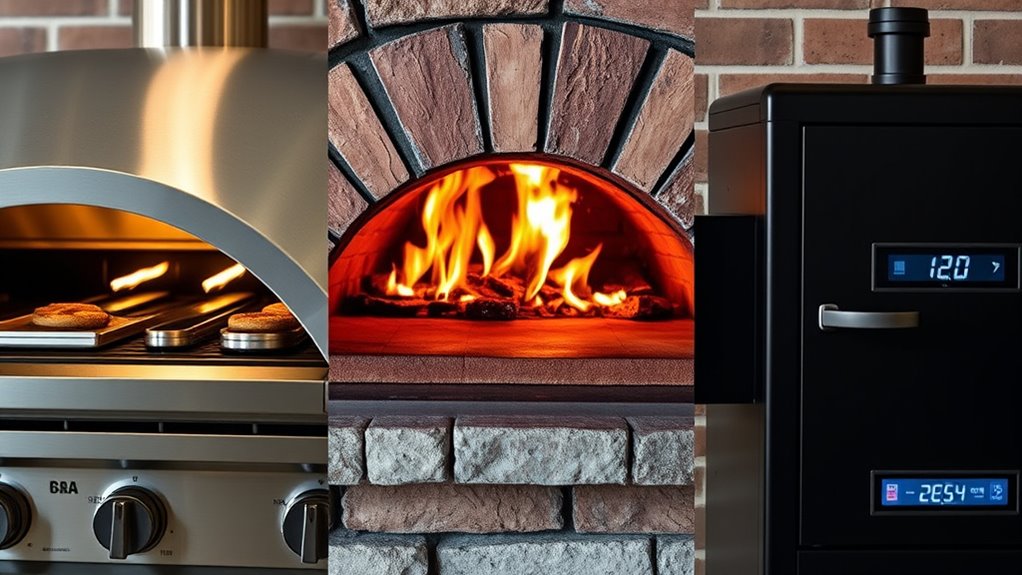
When you choose wood-fired pizzas, you’ll notice smoky aromas that add depth and complexity to each bite. These nuances can enhance the flavor of your crust and toppings, making every slice more memorable. It’s a cooking method that truly elevates the overall pizza experience. Incorporating natural materials such as wood not only contributes to the authentic taste but also adds rustic charm to your cooking environment.
Smoky Aromas and Nuances
The smoky aromas produced by wood-fired pizzas are what truly set them apart, infusing each slice with rich, complex flavors. These smoky nuances deepen the overall flavor profile, adding layers that you can’t quite achieve with other methods. As the wood burns, it releases aromatic compounds that cling to the crust and toppings, creating a subtle yet distinctive smokiness. This aroma enhances the pizza’s taste, making every bite more memorable. The nuanced flavors from the wood’s smoke can range from sweet and fruity to deep and earthy, depending on the type of wood used. This natural infusion elevates your pizza experience, giving it a depth and character that’s hard to replicate with gas or pellet options. Understanding how different woods influence flavor can help you select the perfect type of wood for your desired smoky profile. The smoky nuances truly make wood-fired pizzas uniquely flavorful.
Enhanced Crust and Toppings
A wood-fired oven doesn’t just add smoky complexity; it also transforms your crust and toppings into a symphony of enhanced flavors. The high heat promotes excellent dough elasticity, allowing your crust to develop a perfect balance of crispy exterior and chewy interior. This elasticity ensures toppings adhere better, preventing slipping or sliding during baking. The intense heat creates a quick cook time, locking in fresh ingredients’ flavors and intensifying their natural sweetness. Plus, the quick baking preserves the toppings’ texture and aroma, making each bite more vibrant. The wood’s subtle smoky notes subtly infuse the toppings, elevating their flavor profile without overpowering. Additionally, the use of natural materials in a wood-fired oven aligns with the Cottagecore aesthetic, creating a cozy and authentic experience. Overall, a wood-fired oven enhances your pizza’s crust and toppings, delivering a richer, more satisfying culinary experience.
Pellet Ovens: Convenience and Performance

Pellet ovens have gained popularity because they offer a convenient and reliable way to cook pizza with minimal effort. They use automated cleaning systems, reducing maintenance time, and are known for their energy efficiency, saving you money over time. You simply load the pellets, set your desired temperature, and let the oven do the work. Performance-wise, pellet ovens heat quickly and maintain consistent temperatures, ensuring perfect pies every time. Additionally, their cost efficiency makes them an attractive option for regular pizza enthusiasts.
Installation and Space Considerations

When choosing your pizza oven, you’ll need to think about how much space it requires and where you’ll place it. Ventilation and exhaust needs vary depending on the type, impacting your setup. Installation complexity and costs also differ, so it’s important to plan accordingly. Incorporating predictive analytics can help forecast your long-term setup costs and efficiency needs.
Space Requirements and Size
Choosing the right outdoor pizza oven requires considering the space it will occupy, as each type has different installation needs. Oven placement is essential for safety, convenience, and functionality. Gas ovens tend to be more compact, fitting into smaller spaces with minimal ventilation requirements. Wood-fired models are often larger due to their chimney and insulation needs, requiring more room for proper installation. Pellet ovens strike a balance, generally smaller than traditional wood-fired units but still needing adequate clearance for operation and maintenance. To optimize your setup, focus on space optimization—allowing enough room for safe access, cooking, and cleanup without overcrowding your outdoor area. Measure your available space carefully and choose a size that suits your cooking habits while fitting comfortably in your designated spot. Considering the space requirements for different types of outdoor ovens can help ensure a safe and efficient installation.
Ventilation and Exhaust Needs
The installation space for your outdoor pizza oven must guarantee proper ventilation and exhaust systems to ensure safe operation. Adequate ventilation requirements help prevent smoke buildup and heat accumulation, protecting both you and your surroundings. Your exhaust systems should effectively vent fumes and gases away from cooking areas. Proper airflow is essential for maintaining oven performance and safety. Consider the following table to understand the importance of exhaust system choices:
| Exhaust System Type | Key Benefit |
|---|---|
| Direct Venting | Prevents smoke from spreading |
| Ducted Ventilation | Ensures safe removal of fumes |
| Passive Vents | Suitable for small setups |
| Power Vents | Handles higher heat and fumes |
| Chimney Exhaust | Traditional, effective for heat |
Choosing the right setup ensures safety and efficiency in your outdoor pizza oven. Proper ventilation systems are crucial for optimal operation and safety standards.
Installation Complexity and Cost
Installing an outdoor pizza oven requires careful consideration of both complexity and cost, which vary markedly depending on the type you select. The installation challenges and cost implications differ markedly across options.
- Gas ovens generally need minimal setup, with straightforward connections to existing gas lines, reducing both complexity and expense.
- Wood-fired models demand a dedicated chimney or venting system, increasing installation difficulty and costs.
- Pellet ovens often require electrical connections and specialized venting, adding to the initial investment.
- Space considerations also influence costs—larger, more complex setups need more room and structural support.
- Additionally, understanding AI security risks and ensuring safe installation practices can help prevent potential hazards and mitigate vulnerabilities.
Cost Differences and Budgeting

When comparing the costs of gas, wood, and pellet pizza ovens, it’s important to take into account both upfront expenses and ongoing fuel costs. Your initial investment varies: gas ovens tend to be more affordable initially, while wood and pellet ovens can be pricier. However, fuel efficiency plays a key role in long-term budgeting. Gas ovens usually have lower fuel costs due to consistent and efficient burning, making them more economical over time. Wood and pellet ovens might have higher fuel expenses, but some users find the flavor benefits justify the extra cost. Consider how often you’ll use the oven and how fuel prices fluctuate in your area to make an informed decision. Budgeting smartly means balancing upfront costs with ongoing fuel expenses for the best value. Additionally, projector technology differences, such as efficiency and fuel consumption, can influence long-term costs and should be factored into your planning.
Temperature Control and Consistency

You want to keep your pizza perfect every time, so precise heat management is crucial. Temperature fluctuations can throw off your cooking, making it hard to get that ideal crust and topping doneness. A consistent cooking environment ensures your pizza turns out just right, no matter how many you make.
Precise Heat Management
Achieving precise heat management is essential for consistently perfect pizza results, and the choice of fuel source plays a significant role in controlling temperature and maintaining stability. Your ability to manage heat depends on how well the heat distribution and thermal regulation are controlled within your oven. With gas, you get:
- Even heat distribution through adjustable burners
- Precise temperature control via knobs or digital settings
- Quick adjustments to thermal regulation
- Consistent heat retention for prolonged cooking
Wood offers:
- Natural heat variation, requiring manual control
- Uneven heat spots due to fire placement
- Slower but steady thermal regulation over time
- Unique heat distribution from burning logs
Pellets provide:
- Consistent heat output with automated feeding
- Stable thermal regulation through digital systems
- Even heat distribution with controlled airflow
- Easy adjustments for precise temperature control
Temperature Fluctuations Control
Controlling temperature fluctuations is essential for maintaining consistent pizza quality, and the choice of fuel source directly impacts your ability to do so. Thermostat accuracy plays a crucial role; a precise thermostat ensures you can set and maintain the ideal temperature without constant adjustments. Gas ovens typically offer superior thermostat accuracy, providing stable heat levels, while wood and pellet burners may experience fluctuations due to inconsistent fuel burn. Heat retention is equally important, as well-insulated ovens trap heat efficiently, minimizing temperature swings. Pellets often excel in heat retention because of their uniform size and consistent burn, helping maintain steady temperatures. Your ability to control these fluctuations directly affects pizza crust texture and toppings, making it vital to choose a setup that prioritizes reliable heat management.
Consistent Cooking Environment
Maintaining a consistent cooking environment hinges on effective temperature control and stability throughout the cooking process. This consistency impacts not only the quality of your pizza but also fuel efficiency and safety considerations. To achieve this, consider:
- Using appliances with precise temperature controls to prevent fluctuations.
- Monitoring fuel levels regularly to maintain steady heat.
- Ensuring proper ventilation to avoid dangerous buildup of gases or smoke.
- Adjusting airflow settings to regulate temperature without risking safety hazards.
A stable environment ensures even cooking, minimizes fuel waste, and reduces the risk of accidents. Gas offers quick adjustments for temperature stability, while wood and pellet setups require more attention. Prioritizing consistency keeps your pizza perfect and your cooking process safe.
Ease of Use and Maintenance
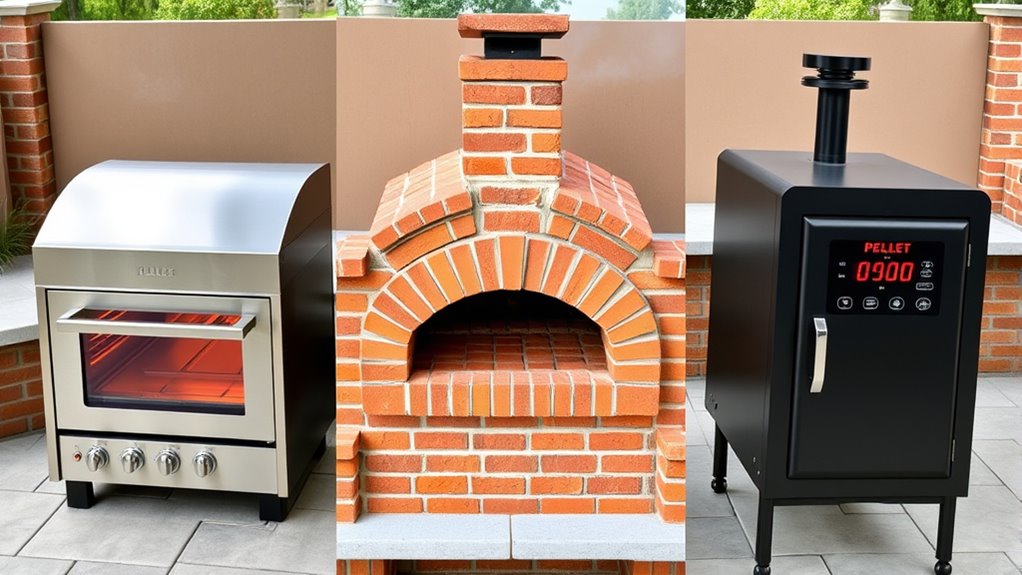
When it comes to ease of use and maintenance, gas pizza ovens generally stand out because they ignite quickly and require minimal cleanup. Cleaning routines are simple since there’s less soot and ash, making ongoing upkeep easier. You won’t need to scrub as often or deal with messy debris like with wood or pellet options. Fuel storage is straightforward, as gas tanks are compact and easy to connect, eliminating the need for storing bulky fuel sources. Just ensure your gas lines are checked regularly for safety. Overall, gas ovens let you focus more on cooking and less on maintenance, making them ideal if you want a hassle-free experience. Their convenience doesn’t compromise performance, providing a reliable, low-maintenance solution for pizza enthusiasts.
Cooking Time and Efficiency
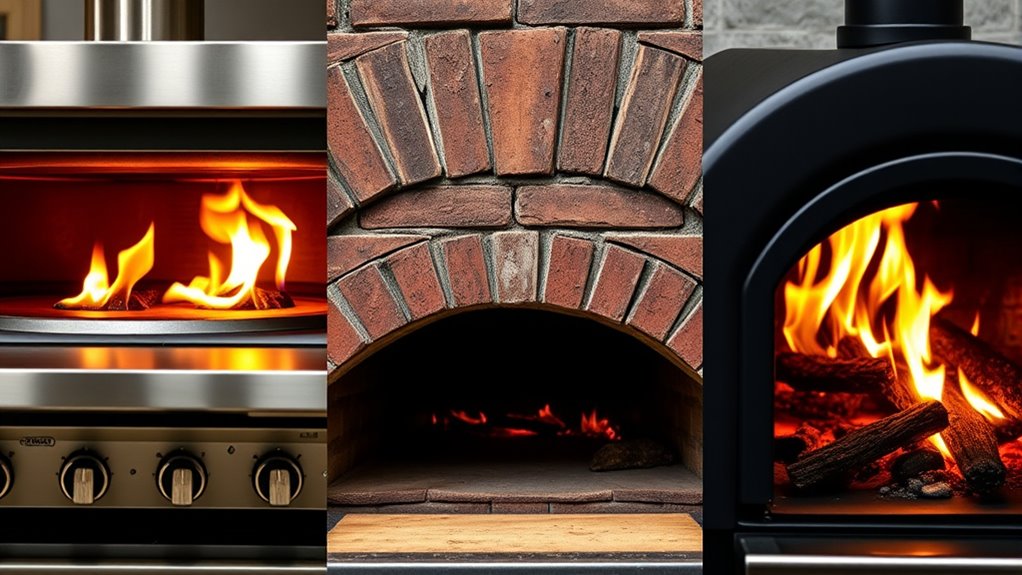
Gas pizza ovens heat up rapidly, allowing you to get your pizza cooking in just a few minutes. Their quick heating translates into faster cooking times and excellent fuel efficiency, saving you both time and energy. When comparing cooking speed and efficiency, consider:
- Gas ovens reach *superior* temperatures in 10-15 minutes, cutting prep time.
- Wood-fired ovens may take 30-45 minutes to heat fully.
- Pellet ovens heat quickly but need time to stabilize temperature.
- Fuel consumption varies, with gas often providing better fuel efficiency per pizza cooked.
This means gas ovens are ideal for quick service and energy savings, making them perfect for frequent use. Wood and pellet options might lag slightly in speed but offer unique flavors and consistent heat once stabilized.
Environmental Impact and Sustainability
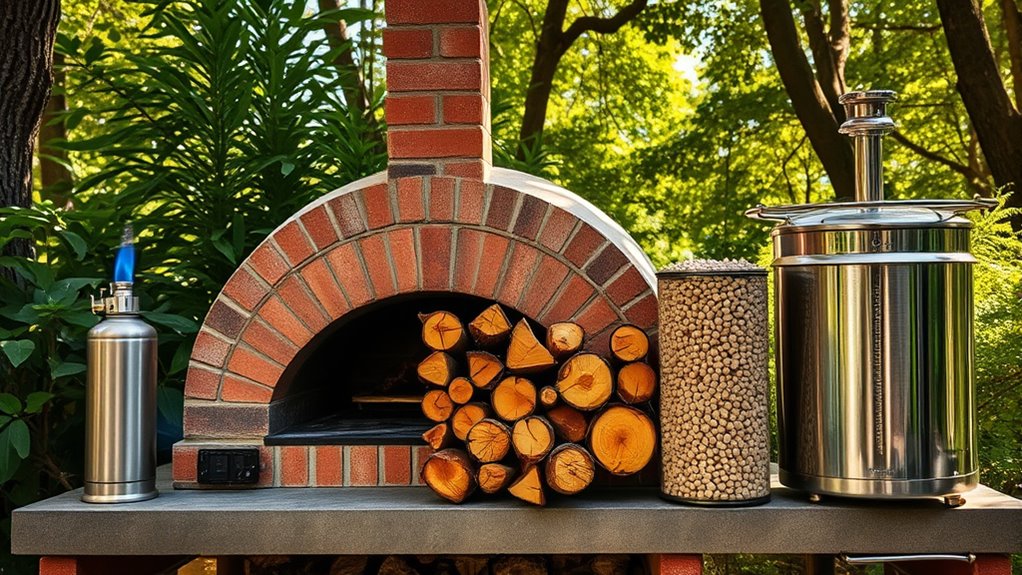
Choosing a pizza oven involves considering its environmental footprint, as each fuel source impacts sustainability differently. Wood ovens often have a higher carbon footprint due to deforestation concerns, but if you source wood sustainably, this impact lessens. Gas ovens typically produce fewer emissions and have a smaller carbon footprint, making them more eco-friendly. Pellet ovens fall somewhere in between, especially when pellets are sustainably sourced. Here’s a quick comparison:
| Fuel Type | Environmental Impact |
|---|---|
| Wood | Higher carbon footprint, sustainable sourcing impacts |
| Gas | Lower carbon footprint, cleaner burning |
| Pellet | Moderate impact, depends on pellet sourcing |
Your choice affects not just flavor but also environmental responsibility.
Choosing the Right Oven for Your Pizza Passion
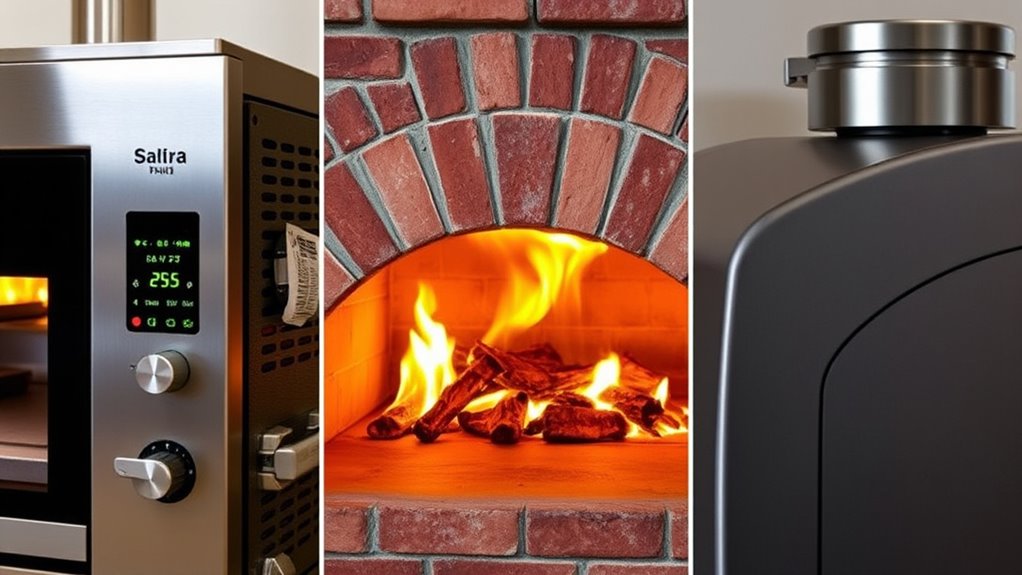
Selecting the right oven is key to elevating your pizza-making experience and achieving the perfect crust and flavor. To do this, consider these factors:
Choosing the right oven elevates your pizza craft with perfect crusts and vibrant flavors.
- Heat Source: Decide between gas, wood, or pellet—each impacts flavor and temperature control.
- Temperature Range: Make sure the oven reaches high temperatures for a crispy crust and properly cooked pizza dough.
- Size and Space: Match the oven size to your available space and expected pizza batch sizes.
- Cooking Environment: Think about ingredient freshness; a consistent oven helps preserve ingredient quality and creates a uniform bake.
Choosing the right oven will help you master your pizza craft, bringing out the best in your ingredients and ensuring every pizza boasts a perfectly cooked crust and vibrant flavors.
Frequently Asked Questions
Which Oven Type Produces the Crispiest Pizza Crust?
You’ll find that wood-fired ovens produce the crispiest pizza crust because they reach higher temperatures, often around 800-900°F, which quickly crisps the dough. To achieve this, guarantee proper oven preheating times and optimize your pizza dough hydration—around 60-65%—for a perfect balance. Gas ovens can also produce crispy crusts, but wood-fired ones give that authentic, smoky crunch that’s hard to match.
How Does Oven Type Affect Pizza Topping Temperature?
Your oven type dramatically influences topping temperature, and it’s like a rocket launch for your pizza! Gas ovens heat quickly and evenly, ensuring toppings reach the perfect temperature without burning. Wood and pellet ovens often run hotter and unevenly, which can cause toppings to cook too fast or unevenly. So, choose an oven with consistent heat to keep your toppings perfectly cooked, avoiding underdone or burnt bits.
Are There Health Concerns With Using Gas or Pellet Ovens?
Yes, there are health concerns with gas and pellet ovens. They can impact indoor air quality due to chemical emissions like nitrogen oxides and volatile organic compounds, which may cause respiratory issues over time. To stay safe, guarantee proper ventilation and regular maintenance. Using these ovens in well-ventilated areas minimizes exposure, helping protect your health from potential risks linked to indoor air quality and chemical emissions.
Can I Cook Frozen Pizzas Effectively in These Ovens?
You can absolutely cook frozen pizza effectively in your oven, but keep in mind that oven efficiency varies. To get the best results, preheat thoroughly and adjust cooking times if needed. Since frozen pizza is already cooked, your goal is just to heat it evenly and crisp the crust. Think of it as hitting two birds with one stone—you save time and enjoy a hot, delicious slice without fuss.
What Are the Long-Term Maintenance Costs for Each Oven Type?
You’ll find that gas ovens generally have lower repair expenses and maintenance costs over time because they have fewer moving parts and simpler systems. Wood-fired ovens may incur higher repair expenses due to chimney cleaning and wear on firebricks. Pellet ovens fall in between, with moderate repair costs mainly related to auger and pellet feed system maintenance. Overall, a clear cost comparison helps you choose the best oven for long-term savings.
Conclusion
No matter which oven you choose—gas, wood, or pellet—you’re about to elevate your pizza game to legendary status. Imagine serving pies that make friends gasp and neighbors drool, all crafted with the perfect oven that feels like an extension of your passion. This isn’t just cooking; it’s creating memorable moments. So pick your weapon, fire it up, and prepare to become the hero of your neighborhood’s pizza legend. Your epic pizza journey starts now!
